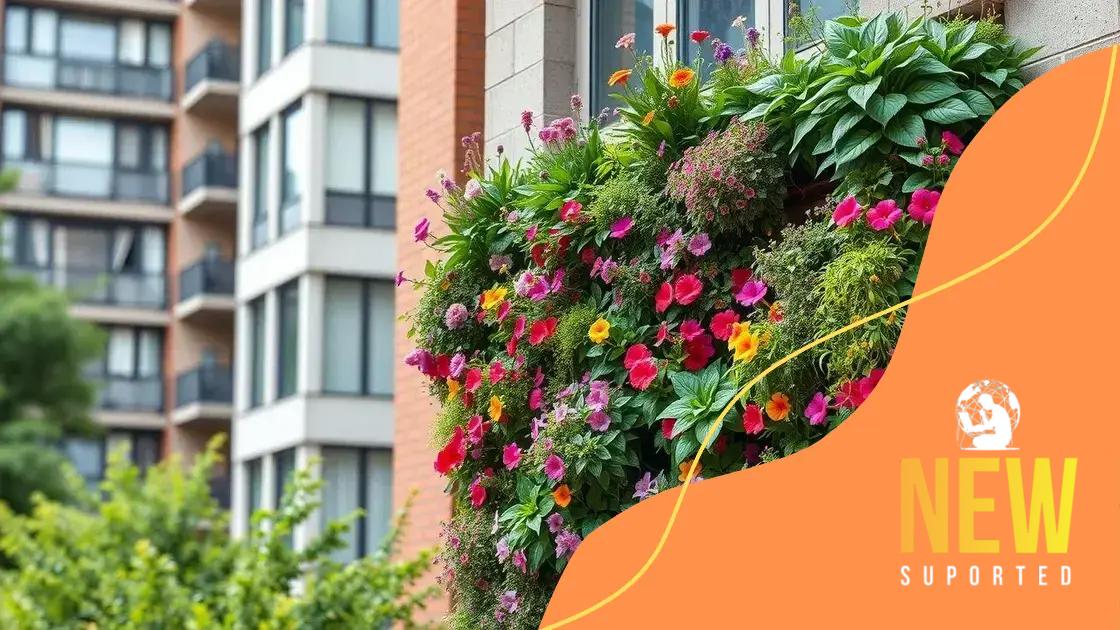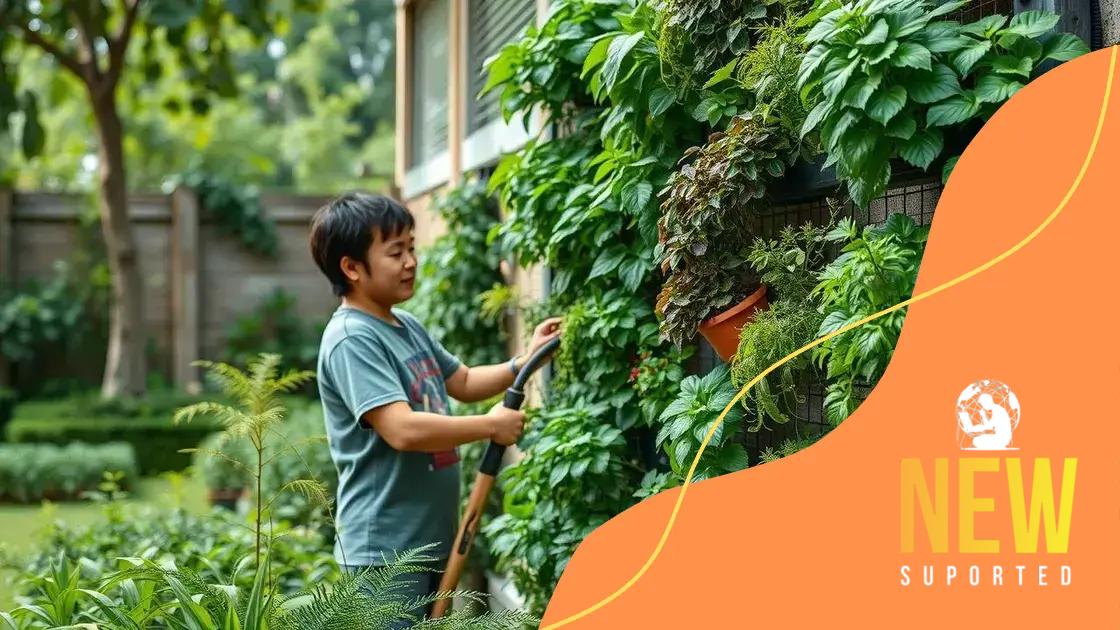The rise of vertical gardens in urban areas

The rise of vertical gardens in urban areas significantly enhances air quality, promotes biodiversity, and transforms city landscapes into green, sustainable spaces that support healthier living environments.
The rise of vertical gardens in urban areas is changing the way we perceive city living. Have you noticed how these green walls bring life to concrete jungles? Dive into the trends, benefits, and inspiration behind this urban gardening revolution.
Benefits of vertical gardens in urban settings
Vertical gardens offer a variety of advantages for urban living that go beyond aesthetics. They are an innovative solution to create green spaces in crowded cities, where every inch counts. Many urban dwellers are discovering how these gardens can transform their surroundings.
Environmental Benefits
One of the primary advantages of vertical gardens is their positive impact on the environment. They help improve air quality by filtering pollutants and producing oxygen. Additionally, vertical gardens can regulate temperature in buildings, leading to lower energy consumption.
Space Optimization
For city residents, space is often limited. Vertical gardens allow you to utilize wall space creatively, turning bland walls into vibrant green landscapes. They can be installed in small patios, balconies, or even indoor spaces.
- Maximize available space
- Beautify urban environments
- Encourage biodiversity
- Inspire community engagement
Moreover, vertical gardens can help reduce noise pollution by acting as natural sound barriers. Their dense foliage absorbs sound, which can make urban areas quieter and more pleasant.
Health and Well-Being
Besides environmental impacts, there are significant health and wellness benefits associated with vertical gardens. Plants can reduce stress, improve mood, and create a more peaceful setting. In homes and offices, these gardens can serve as natural air fresheners, reducing unhealthy chemical exposure.
Engaging with nature, even in limited spaces, fosters a connection between people and their environment. This connection is crucial for promoting mental well-being. As cities grow, the need for innovative green solutions becomes even more pressing.
Design ideas for your own vertical garden
Creating your own vertical garden can be an exciting project that brings nature right into your living space. You can design a vertical garden that reflects your style and fits your available space. Whether you have a small balcony or a spacious wall, vertical gardens can adapt to any environment.
Choosing the Right Plants
The first step in designing your vertical garden is selecting the right plants. Consider choosing plants that thrive in your climate and the amount of sunlight your garden receives. Herbs, succulents, and ferns are popular choices.
- Herbs like basil, mint, and rosemary are great for small spaces.
- Succulents require little maintenance and come in various shapes and colors.
- Ferns offer lush greenery and add texture.
- Flowering plants can bring vibrant colors to your garden.
Mixing different kinds of plants can create a more dynamic and visually appealing design. Additionally, consider the watering needs of each plant to ensure they thrive together.
Vertical Garden Structures
When it comes to constructing your vertical garden, there are numerous options available. You can use wooden pallets, metal frames, or even repurposed materials like old ladders. These structures can be designed to fit your unique space and style.
Consider using wall-mounted planters or pocket systems that hold individual plants and can be easily installed. These options save space while allowing you to create a stunning green display.
Another idea is to install a freestanding vertical garden that can be moved if needed. This flexibility allows you to adapt to changing sunlight conditions or to rearrange your outdoor space.
Maintenance and Care
To keep your vertical garden healthy, regular maintenance is essential. Check for pests and remove any dead leaves. Make sure to water your plants according to their needs. Some may require daily watering, while others might thrive with less.
Fertilizing your plants can help them grow better. Choose a balanced fertilizer that suits your plant types. Regularly trimming and pruning can also encourage healthy growth and shape your garden.
Maintenance tips for thriving vertical gardens

To ensure your vertical garden thrives, regular maintenance is key. Taking care of your plants will not only keep them healthy but also enhance the beauty of your garden. Understanding what your plants need will make your efforts more effective.
Watering Your Vertical Garden
Watering is crucial for the health of your garden. Check your plants frequently to determine their water needs. Some plants may require daily watering while others may thrive on less. Always ensure that water reaches the roots.
- Use a drip irrigation system for even watering.
- Water in the morning to prevent evaporation.
- Avoid letting water sit in the bottom of the planter to prevent root rot.
- Consider the weather; increase watering during hot, dry spells.
Monitoring humidity levels is also important. Some plants may enjoy more humid conditions, while others prefer drier air.
Pest Control and Diseases
Keeping an eye out for pests can save your vertical garden from destruction. Regularly inspect the leaves and stems for any signs of pests like aphids or spider mites. Early detection is crucial, as it is easier to manage small infestations.
For pests, try using natural solutions such as insecticidal soap or neem oil. These options are less harmful to beneficial insects. If you notice any diseased plants, promptly remove them to prevent the spread.
Pruning and Fertilizing
Pruning your plants encourages healthy growth. Remove dead leaves and spent flowers to allow new growth to thrive. It’s also a chance to shape your plants, maintaining a tidy appearance in your garden.
Fertilize your vertical garden every few weeks during the growing season. Use a balanced, water-soluble fertilizer to give your plants the nutrients they need. This will help them bloom and grow robustly.
Strong, healthy plants can better withstand pests and diseases. Making maintenance a regular habit ensures that your vertical garden will flourish.
The impact of vertical gardens on air quality
Vertical gardens have a significant effect on air quality in urban environments. They serve as natural filters, trapping dust and pollutants while creating healthier spaces for city dwellers. With pollution levels rising, the importance of these green spaces cannot be overstated.
How Vertical Gardens Improve Air Quality
Plants play a vital role in cleansing the air. They absorb carbon dioxide and release oxygen through photosynthesis. Vertical gardens increase the number of plants in urban areas without requiring extensive horizontal space, making them an ideal solution for cities.
- They filter harmful particles from the air.
- Vertical gardens reduce greenhouse gases.
- They can lower local temperatures, thereby reducing urban heat islands.
- Plants in these gardens release moisture, improving humidity levels.
Urban heat islands contribute to poor air quality by trapping heat in dense city areas. Vertical gardens help mitigate this effect, promoting cooler air through natural evaporation and transpiration processes. This cooling effect makes the surrounding environment more comfortable and less industrial.
Research and Studies
Numerous studies highlight the positive impacts of vertical gardens on urban air quality. Researchers have found that living walls can reduce particulate matter in the air significantly, leading to better respiratory health for residents. The presence of more greenery has been linked to lower incidences of asthma and other respiratory issues in urban areas.
These gardens also encourage biodiversity, providing habitats for various species and helping in the pollination process, which further contributes to improving local ecosystems.
Creating a Healthier Urban Environment
Incorporating vertical gardens into city planning can lead to more livable spaces. When cities prioritize these green features, they promote a healthier lifestyle. The presence of plants improves mental well-being by reducing stress and enhancing the overall experience of urban life.
By recognizing the power of vertical gardens, cities can take meaningful steps towards a greener, healthier future for their inhabitants, ensuring a balance between nature and urban living.
Examples of successful vertical gardens around the world
Vertical gardens have taken root in many cities globally, showcasing creativity and innovation in urban design. These gardens not only beautify spaces but also demonstrate the benefits of sustainable living. Let’s explore some examples of successful vertical gardens around the world.
1. The Green Building, Sydney
The Green Building in Sydney, Australia, is renowned for its stunning vertical garden designed by Patrick Blanc. This iconic structure provides a lush green facade that integrates over 35,000 plants from different species. It contributes to enhancing biodiversity while effectively reducing the building’s energy consumption.
2. CaixaForum, Madrid
In Madrid, the CaixaForum cultural center features a striking vertical garden designed by French botanist Patrick Blanc as well. This living wall showcases over 15,000 plants and creates a vibrant contrast against the building’s modern architecture. The garden helps in cooling the building and improving air quality, offering a refreshing urban oasis.
3. The Vertical Forest, Milan
Milano’s Vertical Forest is a groundbreaking residential project by architects Boeri Studio. Comprising two high-rise towers, this development features over 9,000 trees and numerous plants. The Vertical Forest promotes sustainability by absorbing CO2 and providing homes for various bird species, merging nature with urban living.
4. One Central Park, Sydney
Also in Sydney, One Central Park is known for its impressive vertical gardens designed by landscape architect Charles Jencks. The project embraces nature with plants cascading down the building’s balconies, creating a lush, green facade. The gardens enhance the visual appeal and contribute to better air quality in the surrounding neighborhood.
5. Bosco Verticale, Milan
Another noteworthy example is the Bosco Verticale, which translates to “Vertical Forest.” It consists of two residential towers filled with trees and greenery at every level. The design not only combats pollution but also offers residents a private green space, combining urban living with nature.
These successful vertical gardens highlight the positive impact of integrating green spaces in urban areas. By observing these examples, cities can draw inspiration to embrace sustainable designs that enhance the quality of life for their residents while combatting environmental challenges.
FAQ – Frequently Asked Questions About Vertical Gardens
What are the main benefits of vertical gardens in urban areas?
Vertical gardens improve air quality, enhance biodiversity, and create visually appealing spaces in crowded cities.
How do vertical gardens help with air pollution?
By filtering pollutants and producing oxygen, vertical gardens act as natural air purifiers, leading to cleaner, healthier air.
What types of plants are best for vertical gardens?
Suitable plants include herbs, succulents, and flowering plants that can thrive in the specific light and watering conditions of vertical gardens.
Do vertical gardens require a lot of maintenance?
While they do require some maintenance, such as watering and pruning, many types of vertical gardens are designed to be low-maintenance.






